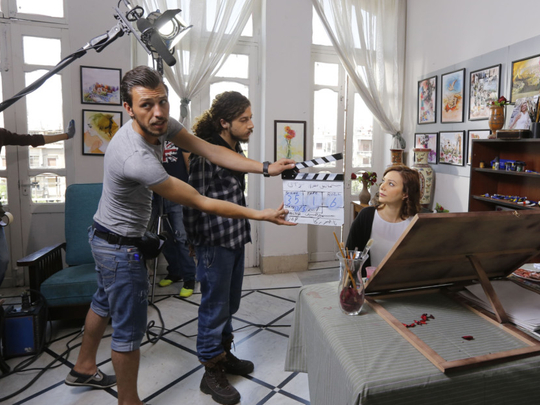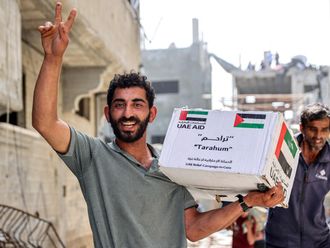
Damascus: The sound of the blast in Syria’s capital Damascus brought worried residents running, but rather than carnage they found a crew filming one of the country’s famed television drama series.
Moments before, director Rasha Sharbatgi had been wielding her loudhailer, calling for silence before counting down to the controlled explosion.
Onlookers arriving at the set near Arnus Square in central Damascus found a burning car and people lying on the ground.
One swore in anger when he discovered the blast that had startled him was a scene being shot for Sharbatgi’s latest series “Shoq”, named for its main character.
She is one of many Syrian artists who have decided to draw inspiration from their country’s bloody six-year conflict.
Her series is among the offerings on television during this year’s fasting season of Ramadan, a peak viewing period for many in the region who settle down to watch after eating their sunset meal.
Syria, along with Egypt, is known as a hub for television and film production in the Middle East, and the country’s war is having a major impact on its output.
“Lately the content of series has varied between love stories, comedy and historical dramas,” Sharbatgi told AFP.
“There has been little in the way of real-life drama because everyone is trying to escape from depicting the current reality and fresh wounds.”
“I personally fled into work on love and relationships over the past three years, but I couldn’t escape all the time,” she added.
“I promised that this year I would do something that focuses on the crisis in a direct manner.”
“Shoq” focuses on the issue of the kidnapped and missing, a painful and sometimes overlooked part of the Syrian conflict, which has killed more than 465,000 people since it began with anti-government protests in March 2011.
It does not shy away from depicting the conflict, featuring scenes of fighting, death and destruction.
“It was very difficult to make,” Sharbatgi conceded.
“But not more difficult than living the reality.”
In addition to providing subject matter, Syria’s conflict has constrained directors.
Once-popular filming locations are now too dangerous to use, and some actors are abroad and unable to return “for economic, security or political reasons”, Sharbatgi said.
The decline in the value of the Syrian pound and general economic malaise has also affected production values.
Director Samir Hussain decided to film his series “Fouda” or “Chaos” in the Al Qasaa area near Damascus’s Jobar district, which remains divided between rebel and government control and is a key front line in the capital.
The series looks at the chaos that has afflicted Syrian society during the war, and the “love and other human stories that have faced challenges because of the conflict”, Hussain said.
A house in Al Qasaa has become the headquarters for Hussain’s crew, with one room turned into a changing room for actors and another used to film scenes.
The windows are kept open to prevent the glass shattering if a shell falls nearby.
Some directors have opted to incorporate landscapes scarred by war directly into their work, including Ahmad Ebrahim Ahmad, who filmed his latest movie “Ma Ward” or “Rosewater” in Daraya.
The town was badly damaged over years of conflict before being captured by the army in August 2016, and fighting was ongoing when Ahmad was filming in the summer of 2016.
“International companies spend thousands of dollars to create scenes of destruction or depict a landscape in war, but here we don’t spend anything — our country has become a real-life set,” Ahmad said.
“In the movie, we used sounds from the artillery and gunfire and included them in our scenes.”












